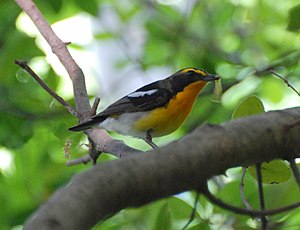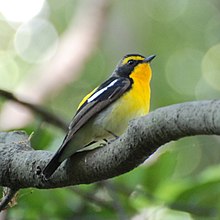Daffodilcatcher
| Daffodilcatcher | ||||||||||||
|---|---|---|---|---|---|---|---|---|---|---|---|---|

Daffodil flycatcher ( Ficedula narcissina ), male |
||||||||||||
| Systematics | ||||||||||||
|
||||||||||||
| Scientific name | ||||||||||||
| Ficedula narcissina | ||||||||||||
| ( Temminck , 1836) |
The daffodilcatcher ( Ficedula narcissina ) is a small songbird belonging to the flycatcher family that is common in the Far East of Russia and Japan . In German it is sometimes referred to as the gold snapper .
Appearance
Adult specimens reach a length of 13 cm and a weight of 11 to 12 grams. The color of the plumage shows a pronounced sexual dimorphism : the male daffodil flycatcher is very brightly colored and striking. The crown, mantle and tail are black. Adult males have a yellow over-eye stripe that widens backwards. Breast and flank plumage are light yellow, the underside of the abdomen is white. The throat has an orange spot. The wings are also colored black with white wing bands. The rump is yellow. In one-year-old males, the neck plumage and coat are often olive or gray-green. The females of the species, on the other hand, are simply colored and have olive-brown to olive-green plumage with a pale stripe over the eyes. The rump is tinted from dull green to yellowish green, the orange patch on the neck and the white wing band of the male are missing. The lower abdomen of the females is gray-white.
Adult specimens have a blue-gray beak, which is colored to black, black eyes and blue-gray feet.
distribution and habitat
The daffodilcatcher inhabits shady deciduous and mixed forests of Northeast Asia as well as evergreen forests in the south of its range . Its breeding area extends from southern Sakhalin , the Kuril Islands and the Ussuri region in the Far East of Russia over the Japanese main islands of Hokkaidō and Honshū to southern Kyushu . Occasionally the species can also be found in South Korea and Taiwan . The wintering areas are on Borneo . During the migration , the daffodilcatcher can also be found in urban parks.
behavior

The species feeds primarily on insects , which it catches in flight or pecks from leaves. In particular, butterfly caterpillars are on the menu, which, according to a study from 2002, the daffodilcatcher follows from the treetops to the forest floor from mid-June . In autumn, the daffodil flycatcher occasionally feeds on berries and seeds.
Mating and breeding take place between mid-April and early July. Japanese hemlocks are primarily chosen for the construction of the teardrop-shaped nest . The nests are preferably made in tree hollows, crevices or especially in dead trees made of withered leaves, moss, hair and other plant material at an average height of 7.3 m. Nest boxes are also gladly accepted.
Taxonomy
The Ficedula elisae, originally classified as a subspecies of the daffodil flycatcher, and the Ryūkyū flycatcher ( Ficedula owstoni ) are now largely regarded as separate species. The species Ficedula beijingnica described in 1999 has turned out to be a subadult form of Ficedula elisae . While the daffodilcatcher is not endangered in its population, further studies on the independence of F. elisae and F. owstoni could determine whether they require special protective measures due to their low distribution.
Individual evidence
- ↑ a b c d Brazil, Mark: Birds of East Asia , London 2009, p. 436
- ↑ Masashi Murakami: Foraging mode shifts of four insectivorous bird species under temporally varying resource distribution in a Japanese deciduous forest. Ornithole. Sci 1 (2002), pp. 63-69
- ↑ Yuji Okahisa, Gen Morimoto, and Kentaro Takagi: The Nest Sites and Nest Characteristics of Narcissus Flycatcher Ficedula narcissina. Ornithological Science (Dec 2012): Vol. 11, Issue 2, pp. 87-94 doi : 10.2326 / osj.11.87 .
- ^ NJ Collar & JD Pilgrim: Species-level changes proposed for Asian birds, 2005-2006. Birding ASIA 8 (2007), pp. 14-30
- ^ Robson, C. (2005) Birds of Southeast Asia. London: New Holland
- ↑ BirdLife International (2013) Species factsheet: Ficedula narcissina. Downloaded from Birdlife International on 07/12/2013.
Web links
- Ficedula narcissina inthe IUCN 2013 Red List of Threatened Species . Listed by: BirdLife International, 2012. Retrieved December 31, 2013.
- BirdLife International: Species Factsheet - Narcissus Flycatcher ( Ficedula narcissina ) . Retrieved December 31, 2013.
- Videos, photos and sound recordings of Narcissus Flycatcher (Ficedula narcissina) in the Internet Bird Collection
- Goldcatcher ( Ficedula narcissina ) at Avibase; accessed on December 31, 2013.
- Ficedula narcissina in the Integrated Taxonomic Information System (ITIS). Retrieved December 31, 2013.
- xeno-canto: sound recordings - Narcissus Flycatcher ( Ficedula narcissina )